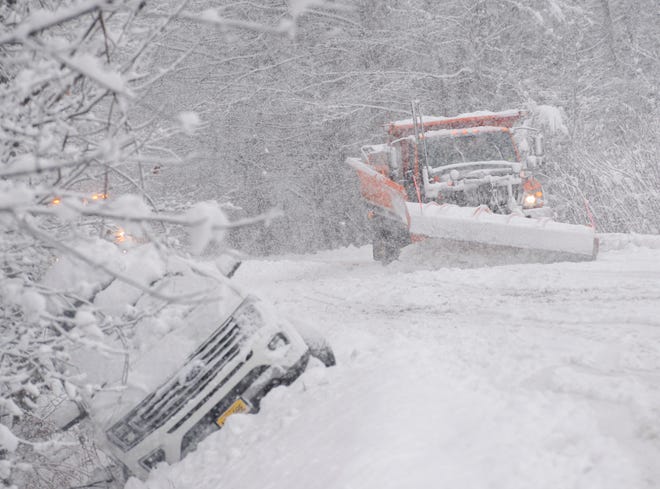
With winter a day away, a strengthening pre-Christmas blizzard that experts say could become a bomb cyclone is set to bring heavy snow, strong wind gusts and plummeting temperatures to the Central and Northern Plains, Upper Midwest and Great Lakes this week.
The winter storm system brewing along an incoming Arctic front could create treacherous holiday travel conditions as federal forecasters expect the blizzard to slam much of the Midwest and Great Lakes late Wednesday through Christmas Eve.
Winter storm warnings, wind chill warnings and winter weather advisories were in effect across parts of the Midwest and Pacific Northwest – where up to 24 inches of additional snow was anticipated in Washington on Tuesday.

Meanwhile, the National Weather Service issued a winter storm watch for over 40 million people in the North Central U.S., including Chicago, where forecasters expected high winds and low temperatures to be more of a concern than snow.
WINTER STORM READY:Best ways to prepare yourself and your home for a blizzard
WHAT DEFINES A BLIZZARD? Heavy snow and high winds expected to sweep across country
By Friday, heavy rain drenching a melting snowpack may trigger flooding concerns across the Northeast, according to the weather service.
Here's what to know about the blizzard expected to impact the U.S. ahead of Christmas:
When is the snowstorm expected to hit this week?
National Weather Service forecasters expect the storm system to develop Wednesday night and gather strength before heading over the Great Lakes by early Friday. Blizzard conditions were likely to unfold across the Midwest on Thursday in places like Nebraska, Iowa, Indiana, Michigan and Illinois, according to AccuWeather.

The Windy City can expect to live up to its nickname Thursday and Friday, when the strongest gusts along with falling snow will help temperatures drop to minus 20 F and minus 25 F, according to NWS Chicago.
16 BILLION-DOLLAR DISASTERS:How the US was impacted by weather in 2022
Chicago's deteriorating conditions may also cause low to zero visibility during the peak storm period from Thursday afternoon to Friday morning, National Weather Service meteorologist Brett Borchardt told USA TODAY.
Also on Thursday, sleet and freezing rain were expected to fall over the Ohio Valley into parts of Pennsylvania, Maryland and the Virginias, according to AccuWeather.

How frigid could the temperatures get in the US?
The short answer: extremely cold in some spots. Over 26 million people were under a National Weather Service-issued wind chill watch in parts of the North Central and South Central U.S. on Tuesday. Federal forecasters predicted bitter cold and dangerous wind chills over the northern Plains that would surge south over the central U.S. by Thursday.
Meteorologists in the Twin Cities forecasted wind chills as cold as minus 40 F Thursday through Friday. Even locations as far south as Orlando, Florida, could potentially see below-freezing conditions this week, according to AccuWeather meteorologist Alex DaSilva.
WHAT IS WIND CHILL? Understanding the wind chill index and how it's calculated
Temperatures could drop up to 30 degrees below normal for the center of the country from the Gulf Coast up to the Northeast, DaSilva said.
“Records will be challenged in some areas, but you’re not going to be seeing records fall in every state,” he said, calling the plummeting temperatures “very impressive” for this time of year.
'BIG MESS' AHEAD:Major winter storm to bring snow, arctic temps and travel headaches

When will this blizzard become a bomb cyclone?
It’s likely to happen Thursday into Friday, according to DaSilva, who defined a bomb cyclone as the dropping of a storm’s atmospheric pressure by 24 millibars in 24 hours.
“It's a measure of rapid strengthening of a storm, and it does look like the storm will achieve that ‘bomb-cyclone’ status because it's going to strengthen pretty rapidly," DaSilva said.
WHAT IS A BOMB CYCLONE: A winter hurricane, explained
What are the blizzard's expected impacts?
- Heavy snowfall and wind gusts may cause near-zero visibility and drifting of snow, leading to dangerous and at times impossible air and land travel ahead of the holiday weekend, according to the National Weather Service.
- The blizzard could knock down trees and trigger power outages, making home heating and burst water pipes an issue for some, experts warned.
- Coastal flooding could also threaten the Northeast, including New England, by Friday, according to AccuWeather.









